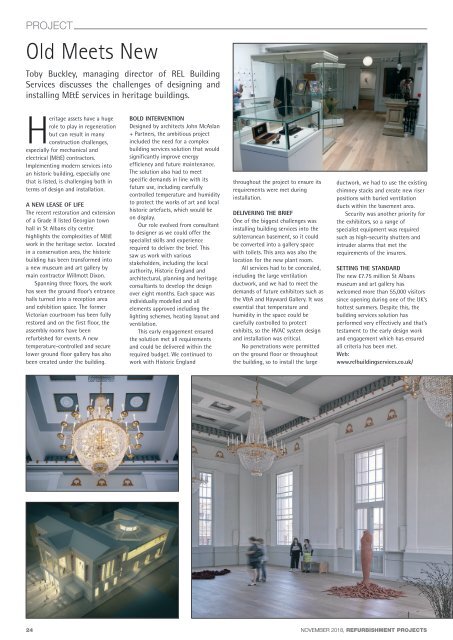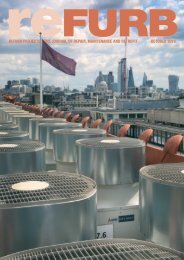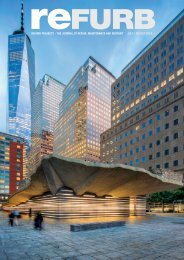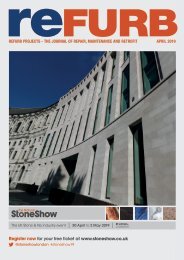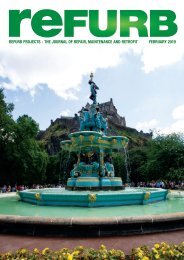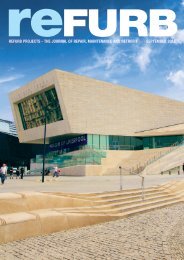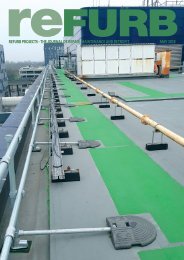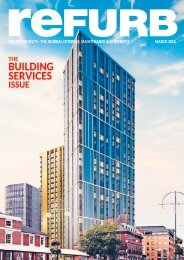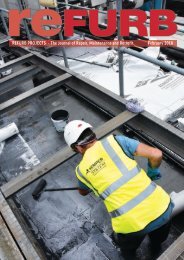Refurb Projects - November 2018
Refurb Projects launched in 1987 to cater for the expanding Repair, Maintenance, Improvement and Refurb sectors of the UK Building Industry. This represents a massive market, with refurbishment in the Health, Leisure, Education and Social Housing sectors expecting to be the mainstay of the industry for the foreseeable future. Sustainability and the protection of the built environment are essential ingredients of the refurbishment market, and Refurb Projects Journal is a leader in reporting and promoting these ideals.
Refurb Projects launched in 1987 to cater for the expanding Repair, Maintenance, Improvement and Refurb sectors of the UK Building Industry. This represents a massive market, with refurbishment in the Health, Leisure, Education and Social Housing sectors expecting to be the mainstay of the industry for the foreseeable future. Sustainability and the protection of the built environment are essential ingredients of the refurbishment market, and Refurb Projects Journal is a leader in reporting and promoting these ideals.
You also want an ePaper? Increase the reach of your titles
YUMPU automatically turns print PDFs into web optimized ePapers that Google loves.
PROJECT<br />
Old Meets New<br />
Toby Buckley, managing director of REL Building<br />
Services discusses the challenges of designing and<br />
installing M&E services in heritage buildings.<br />
Heritage assets have a huge<br />
role to play in regeneration<br />
but can result in many<br />
construction challenges,<br />
especially for mechanical and<br />
electrical (M&E) contractors.<br />
Implementing modern services into<br />
an historic building, especially one<br />
that is listed, is challenging both in<br />
terms of design and installation.<br />
A NEW LEASE OF LIFE<br />
The recent restoration and extension<br />
of a Grade II listed Georgian town<br />
hall in St Albans city centre<br />
highlights the complexities of M&E<br />
work in the heritage sector. Located<br />
in a conservation area, the historic<br />
building has been transformed into<br />
a new museum and art gallery by<br />
main contractor Willmott Dixon.<br />
Spanning three floors, the work<br />
has seen the ground floor’s entrance<br />
halls turned into a reception area<br />
and exhibition space. The former<br />
Victorian courtroom has been fully<br />
restored and on the first floor, the<br />
assembly rooms have been<br />
refurbished for events. A new<br />
temperature-controlled and secure<br />
lower ground floor gallery has also<br />
been created under the building.<br />
BOLD INTERVENTION<br />
Designed by architects John McAslan<br />
+ Partners, the ambitious project<br />
included the need for a complex<br />
building services solution that would<br />
significantly improve energy<br />
efficiency and future maintenance.<br />
The solution also had to meet<br />
specific demands in line with its<br />
future use, including carefully<br />
controlled temperature and humidity<br />
to protect the works of art and local<br />
historic artefacts, which would be<br />
on display.<br />
Our role evolved from consultant<br />
to designer as we could offer the<br />
specialist skills and experience<br />
required to deliver the brief. This<br />
saw us work with various<br />
stakeholders, including the local<br />
authority, Historic England and<br />
architectural, planning and heritage<br />
consultants to develop the design<br />
over eight months. Each space was<br />
individually modelled and all<br />
elements approved including the<br />
lighting schemes, heating layout and<br />
ventilation.<br />
This early engagement ensured<br />
the solution met all requirements<br />
and could be delivered within the<br />
required budget. We continued to<br />
work with Historic England<br />
throughout the project to ensure its<br />
requirements were met during<br />
installation.<br />
DELIVERING THE BRIEF<br />
One of the biggest challenges was<br />
installing building services into the<br />
subterranean basement, so it could<br />
be converted into a gallery space<br />
with toilets. This area was also the<br />
location for the new plant room.<br />
All services had to be concealed,<br />
including the large ventilation<br />
ductwork, and we had to meet the<br />
demands of future exhibitors such as<br />
the V&A and Hayward Gallery. It was<br />
essential that temperature and<br />
humidity in the space could be<br />
carefully controlled to protect<br />
exhibits, so the HVAC system design<br />
and installation was critical.<br />
No penetrations were permitted<br />
on the ground floor or throughout<br />
the building, so to install the large<br />
ductwork, we had to use the existing<br />
chimney stacks and create new riser<br />
positions with buried ventilation<br />
ducts within the basement area.<br />
Security was another priority for<br />
the exhibitors, so a range of<br />
specialist equipment was required<br />
such as high-security shutters and<br />
intruder alarms that met the<br />
requirements of the insurers.<br />
SETTING THE STANDARD<br />
The new £7.75 million St Albans<br />
museum and art gallery has<br />
welcomed more than 55,000 visitors<br />
since opening during one of the UK’s<br />
hottest summers. Despite this, the<br />
building services solution has<br />
performed very effectively and that’s<br />
testament to the early design work<br />
and engagement which has ensured<br />
all criteria has been met.<br />
Web:<br />
www.relbuildingservices.co.uk/<br />
24 NOVEMBER <strong>2018</strong>, REFURBISHMENT PROJECTS


